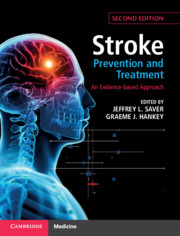Book contents
- Stroke Prevention and Treatment
- Stroke Prevention and Treatment
- Copyright page
- Dedication
- Contents
- Contributors
- Preface
- Part I Foundations
- Part II Systems of Care
- Part III Acute Treatment of Ischaemic Stroke and Transient Ischaemic Attack
- Part IV Acute Treatment of Haemorrhagic Stroke
- Part V Prevention
- Chapter 15 Prevention of Stroke by Lowering Blood Pressure
- Chapter 16 Prevention of Stroke by Lowering Blood Cholesterol Concentrations
- Chapter 17 Prevention of Stroke by Modification of Additional Vascular and Lifestyle Risk Factors
- Chapter 18 Drugs, Devices, and Procedural Therapies to Prevent Recurrent Cardiogenic Embolic Stroke
- Chapter 19 Long-term Antithrombotic Therapy for Large and Small Artery Occlusive Disease
- Chapter 20 Carotid and Vertebral Artery Revascularization
- Chapter 21 Cervical Artery Dissection and Cerebral Vasculitis
- Chapter 22 Prevention of Intracerebral and Subarachnoid Haemorrhage
- Part VI Stroke Rehabilitation and Recovery
- Index
- References
Chapter 15 - Prevention of Stroke by Lowering Blood Pressure
from Part V - Prevention
Published online by Cambridge University Press: 15 December 2020
- Stroke Prevention and Treatment
- Stroke Prevention and Treatment
- Copyright page
- Dedication
- Contents
- Contributors
- Preface
- Part I Foundations
- Part II Systems of Care
- Part III Acute Treatment of Ischaemic Stroke and Transient Ischaemic Attack
- Part IV Acute Treatment of Haemorrhagic Stroke
- Part V Prevention
- Chapter 15 Prevention of Stroke by Lowering Blood Pressure
- Chapter 16 Prevention of Stroke by Lowering Blood Cholesterol Concentrations
- Chapter 17 Prevention of Stroke by Modification of Additional Vascular and Lifestyle Risk Factors
- Chapter 18 Drugs, Devices, and Procedural Therapies to Prevent Recurrent Cardiogenic Embolic Stroke
- Chapter 19 Long-term Antithrombotic Therapy for Large and Small Artery Occlusive Disease
- Chapter 20 Carotid and Vertebral Artery Revascularization
- Chapter 21 Cervical Artery Dissection and Cerebral Vasculitis
- Chapter 22 Prevention of Intracerebral and Subarachnoid Haemorrhage
- Part VI Stroke Rehabilitation and Recovery
- Index
- References
Summary
For hypertensive patients without prior stroke, TIA, or other symptomatic vascular disease, anti-hypertensive therapy reducing SBP by 10 mm Hg, is associated with reductions in recurrent stroke (by about one-quarter) and of combined stroke, MI, and vascular death (by about one-fifth). Benefit extends across all ages, race-ethnicities, and pathological stroke subtypes. Combined pharmacological and non-pharmacological therapy to lower blood pressure is indicated in all individuals with SBP> 140 or DBP> 90, and in individuals with SBP 130–139 or DBP 80–89 who have additional vascular risk factors. Non-pharmacological blood pressure lowering is indicated in individuals with SBP 130–139 or DBP 80–89 without important additional vascular risk factors. After an ischaemic stroke or TIA, treatment may be gradually started as early as 24–72 hours after onset. The absolute benefits of antihypertensive therapy increase with greater reductions in BP, and are higher for preventing recurrent stroke than for preventing MI, in both primary and secondary prevention. The degree of BP reduction more greatly influences vascular event prevention than does pharmacological agent class. Nonetheless, unless otherwise indicated, beta-blockers are not a preferred agent, as they show less efficacy for stroke prevention. Calcium channel antagonists, ACE inhibitors, and thiazide diuretics are particularly well-studied.
Keywords
- Type
- Chapter
- Information
- Stroke Prevention and TreatmentAn Evidence-based Approach, pp. 289 - 296Publisher: Cambridge University PressPrint publication year: 2020

